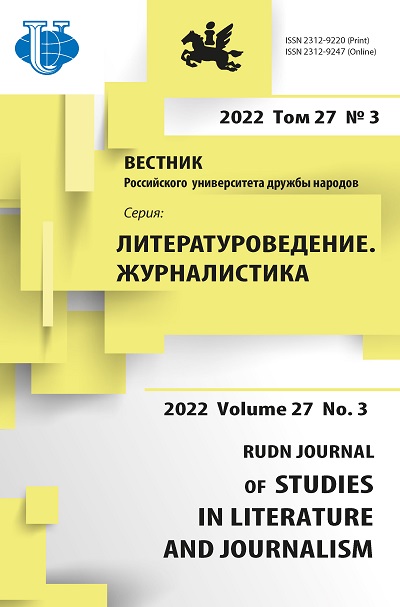Sleep paralysis: at intersection of biology and folklore
- Authors: Povetkina P.B.1
-
Affiliations:
- Lomonosov Moscow State University
- Issue: Vol 27, No 3 (2022)
- Pages: 514-522
- Section: LITERARY CRITICISM
- URL: https://journals.rudn.ru/literary-criticism/article/view/32304
- DOI: https://doi.org/10.22363/2312-9220-2022-27-3-514-522
Cite item
Full Text
Abstract
The author examines the concept of “sleep paralysis” from the point of view of biology and folk culture. The key components of this concept, highlighted by various authors, touches on the main problems related to this concept, including the relationship between biological and cultural in the context of sleep paralysis, are presented. In addition, the work describes possible interpretations of sleep paralysis, mythological characters associated with it in the folklore of different peoples of the world, and folklore genres in which it is reflected. Moreover, the article contains examples of narratives about cases of sleep paralysis in folklore; outside the cultural tradition, where mythological characters associated with sleep paralysis are known; as well as an example of the appearance of mythological characters connected with manifestations of sleep paralysis not in a mythological text, but in other folklore genres.
Keywords
About the authors
Polina B. Povetkina
Lomonosov Moscow State University
Author for correspondence.
Email: diana_middls@mail.ru
ORCID iD: 0000-0002-8246-5367
Master of Cultural Studies, postgraduate student, Department of Russian Folklore
1 Leninskie Gory, Moscow, 119991, Russian FederationReferences
- Adler, Sh. (2011). Sleep paralysis. Night-mares, nocebos, and the mind-body connection. New Brunswick, New Jersey: London Rutgers University Press
- Cheyne, J.A., Newby-Clark, I.R., & Rueffer, S.D. (1999). Relations among hypnagogic and hypnopompic experiences associated with sleep paralysis. Journal of Sleep Research, 8(4), 313-317. http://doi.org/10.1046/j.1365-2869.1999.00165.x
- Cheyne, J.A., Rueffer, S.D., & Newby-Clark, I.R. (1999). Hypnagogic and hypnopompic hallucinations during sleep paralysis: Neurological and cultural construction of the nightmare. Consciousness and Cognition, 8(3), 319-337
- Denis, D., French, S.S., & Gregory, A.M. (2017). A systematic review of variables associated with sleep paralysis. Sleep Medicine Reviews (pp. 1-17).
- Hufford, D.J. (2005). Sleep paralysis as spiritual experience. Transcultural Psychiatry, 42(1), 11-45.
- Khristoforova, O.B. (2020). Is gnetke a sleep paralysis? The unusual between folkloristic and medical classifications. Steps, 6(4), 101-125. (In Russ.)
- Kolberg, O. (1882). All works. Poznan voivodeship (vol. 15, part 7). Kraków: JU Publ. (In Pol.)
- Kolberg, O. (1962). All works. Lublin voivodeship (vol. 17, part 2). Wrocław, Poznań: Polish Music Publishing House, People's Publishing Cooperative. (In Pol.)
- Lazareva, A.A. (2018). The brownie, the walking dead and the soul that left the body: Interpretations of sleep paralysis in East Slavic culture. In O.B. Khristoforova & D.I. Antonov (Eds.) Demonology as Semiotic System: Materials of the Fifth International Scientific Conference (pp. 94-98). Moscow. (In Russ.)
- Milne, L S. (2017). The terrors of the night: Charms against the nightmare and the mythology of dreams. Incantatio. An International Journal on Charms, Charmers and Charming, (6), 78-116.
- Lomonosov Moscow State University, Pinega Regional Department for Culture and Art. (1995). Mythology of Pinega. Karpogory. (In Russ.)
- Plotnikova, A.A. (2016). Slavic island areas: Archaic and innovation. Мoscow: Institute of Slavic Studies, Russian Academy of Sciences. (In Russ.)
- Świętek, J. (1893). The people of the Rab region (from Gdów to Bochnia). Kraków: Polish Academy of Arts and Sciences. (In Pol.)
















